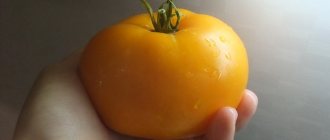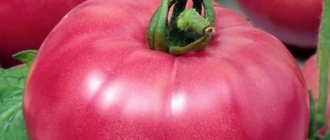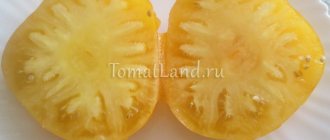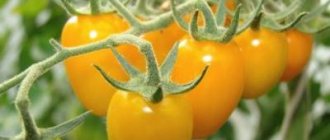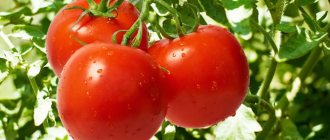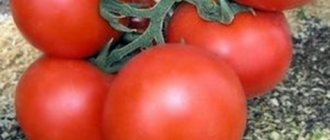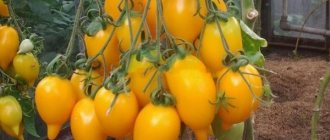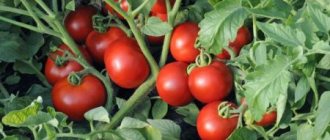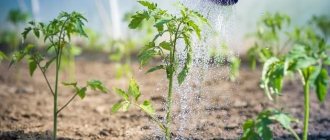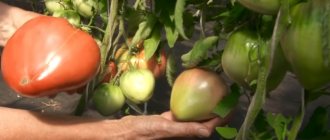History of selection
The tomato “Verochka F1” became the original variety of breeder V.I. Blokin-Mechtalin. It has high product and taste characteristics. Resistant to sudden changes in weather conditions and diseases.
Tomato “Verochka F1” was produced in 2021. After passing the tests, the variety was included in the State Register of the Russian Federation in 2021. There is an opinion among vegetable growers that it received its affectionate name in honor of the breeder’s daughter.
Tomatoes “Verochka F1” are easy to transport and can be stored for a long time
Vegetable growers who grow the Verochka F1 tomato are satisfied with the results. It has found its place of honor in the niche of early-ripening salad varieties.
History of creation
Many breeders tried to neutralize the insufficiently sweet and pleasant taste of early varieties. At the very beginning of the 2000s, Russian agricultural specialists brilliantly solved this problem. They were able to combine early ripening with a significant improvement in taste in a new hybrid called Verochka. The name appeared in honor of the daughter of the author of this project.
Until now, the tomato has not been included in the State Breeding Register, but the hybrid has received many high marks from demanding gourmets and experts. It is noted that the scope of use of this variety is very wide, since it can be grown in most regions, and it is also suitable for both indoor and outdoor cultivation.
Description of the tomato variety Verochka
The “Verochka F1” tomato belongs to the first generation hybrids, as indicated by the abbreviation “F1” in its name. The author managed to combine excellent varietal characteristics and high taste qualities of tomatoes.
Important! A significant disadvantage of the hybrid is the impossibility of independently preparing seeds for the next season. They do not retain their qualities.
Determinate tomatoes “Verochka F1” form low-growing bushes, rarely exceeding a height of 1 m. On average, it is 60-80 cm. It grows in the form of a bush, with fleshy, slightly creeping shoots of light green color. Needs regular removal of stepsons and installation of supports.
The plant is well leafy. The leaf blades of the Verochka F1 tomato are medium-sized and have a rich dark green hue. Matte, with slight pubescence. The hybrid blooms with small bright yellow funnel-shaped flowers. They are collected in simple racemose inflorescences. In each of them 5-7 ovaries are formed. The first brush is laid over the 6th or 7th leaf, then they are formed through 2 leaf plates. Unlike many varieties, the Verochka F1 tomato completes the formation of the bush with a flower brush.
Variety “Verochka F1” is high-yielding, about 10 kg of selected fruits can be collected from one bush
Early ripening hybrid. The first tomatoes can be harvested 75-90 days after emergence - at the end of June or beginning of July, depending on growing conditions and weather. Fruiting of "Verochka F1" is long - up to 1-1.5 months. Tomatoes ripen in waves. However, they ripen together in one cluster, which makes it possible to harvest in whole bunches.
Description of fruits
Tomatoes "Verochka F1" are medium-sized, weighing 90-110 grams. Tomatoes are aligned by size. They have a flat-round shape with slight ribbing. The skin is glossy and appears dense. However, the appearance is deceiving due to the thick, fleshy walls of the tomatoes.
At the stage of technical ripeness, the fruits are green or orange-brown in color. Gradually they take on a bright red-orange color. Fully ripened tomatoes turn scarlet. There is no greenish or brown spot on the stalk.
Tomatoes “Verochka F1” are fleshy, with dense walls. They form no more than 5 chambers with a small number of small seeds. The tomato has an excellent taste, moderately sweet, with a light refreshing sourness in the aftertaste.
The commercial characteristics of the variety are also excellent. Tomatoes are stored for a long time without losing their attractive appearance and taste. When transported over long distances, the fruits do not crack and are well preserved.
Description
The hybrid is classified as super-determinant - this means that it has limited growth, but there is no active growth of stepsons. This feature makes caring for the crop much easier. When growing in open ground, the bush is more compact - up to 60 cm, and in a greenhouse it can reach a height of 1 m.
Related article:
Growing sweet tomatoes in a greenhouse
The plant is small, with a well-developed main shoot. There is a lot of foliage, but the bush looks neat. Compactness is created due to the fact that the internodes are shortened, so the yield remains at a high level. The leaves are petiolate, large, bright green. Thanks to this, the bushes look quite decorative.
This effect is especially enhanced during the fruiting period: beautiful dense clusters grow, each of them develops 5-6 fruits.
A distinctive feature of this hybrid is that the lower and upper clusters do not differ much in the weight of the tomatoes.
The length of the entire cluster is up to 20 cm. Moreover, the fruits are almost always of the correct round shape, and deformations are almost never encountered. The peel is glossy, dense, and not prone to cracking even after full ripening. At first the tomato is light green, but then it quickly acquires a rich red color.
Related article:
To make the tomatoes bigger
Verochka's main advantage is taste. The pulp is fleshy and at the same time juicy, has a pronounced sweetish taste and a fresh tomato aroma. The seeds are located in small chambers, they themselves are small and soft, their quantity is moderate. The average size of tomatoes is 120-150 g.
Characteristics of tomato Verochka
The Verochka F1 tomato has good characteristics for an early ripening variety. The variety is resistant to sudden changes in temperature and humidity. A high degree of cold resistance allows it to develop well and bear fruit in cool and damp summers. But hot weather does not threaten the ovaries falling off and the formation of unmarketable fruits. The hybrid requires moderate watering, which is increased at the time of active fruiting.
Tomato yield Verochka and what affects it
Breeders position the variety as high-yielding. Up to 5 kg of aromatic vegetables are harvested from one bush. Considering the compact size of the plant and high planting density, in favorable conditions, 14-18 kg of tomatoes are obtained from 1 m². The photo shows the tomato “Verochka F1” during the fruiting period.
Tomatoes are used for preparing snacks and salads, and can also be used as preserves.
To achieve maximum yield, you must:
- Select a well-lit place for growing, with light soil and rich in organic elements.
- Feed tomatoes, alternating organic and mineral fertilizers.
- Remove stepsons and form bushes using supports.
- Do not allow tomatoes to overripe on the branches, thereby stimulating the ripening of new ones.
Tomato "Verochka F1" is unpretentious in care. Even beginners in vegetable growing can get a good harvest.
Resistance to diseases and pests
The variety is resistant to diseases. It is not prone to damage by crown rot and various types of mosaics. “Verochka F1” can bear fruit until the moment when weather conditions activate pathogenic late blight fungi.
Tomatoes are rarely targeted by pests such as aphids or spider mites. But mole crickets can sometimes live on the roots. This is especially true for young plants.
Area of application of fruits
Hybrid “Verochka F1” is a salad variety. Tomatoes are suitable for fresh consumption, salads and snacks. They are used to decorate culinary dishes. Many housewives make tomato paste and lecho from tomatoes.
The first fruits can be collected in early July
Area of application of fruits
Verochka F1 was developed for universal use. Tomatoes are great for first vegetable salads, but their high taste characteristics allow them to be consumed fresh on their own. Experts classify them as a dessert type.
Related article:
How to speed up the ripening of tomatoes
The high concentration of vegetable sugar in the pulp makes them a good option for pickling. If you take into account the average weight of tomatoes, it becomes clear that they are also used for marinades. After heat treatment, they do not burst or lose their integrity. The hybrid is also suitable for the production of juices or ketchups.
Advantages and disadvantages
There are a few more reviews about Verochka F1 tomatoes. But they are predominantly positive. Gardeners who grow hybrids note:
- high productivity;
- early ripening;
- versatility of cultivation;
- resistance to the vagaries of weather;
- immunity to viral and fungal diseases;
- attractive appearance of fruits and their uniformity in size;
- long shelf life and transportability;
- excellent taste.
The disadvantages include:
- medium size tomatoes;
- the need for pinching and formation of bushes;
- high cost of seed material.
There is an opinion that the variety is not suitable for whole-fruit canning due to its dense pulp.
Diseases and pests
The Verochka tomato has stable resistance to diseases such as fruit cracking and blossom end rot. In addition, Verochka demonstrates low susceptibility to diseases such as late blight, viral mosaic, and alternaria. This means that even if the plant gets sick with one of these garden diseases, the damage will not be great.
At the same time, the plant can be attacked by harmful insects, which cause significant damage to the leaves and fruits. These pests include:
- aphid;
- Colorado beetle;
- mites;
- slugs
The fight against these insects involves the proper use of insecticidal solutions. It makes sense to collect Colorado beetles and their larvae by hand. For slugs, it is advisable to install special catching devices, which can be purchased at the agricultural market.
Features of planting and care
The hybrid "Verochka F1" is grown mainly by seedlings. Seeds for seedlings are sown in mid-March. If you plan to transplant into open ground, then the timing is shifted to the end of the first month of spring.
To grow seedlings, you can use either purchased universal soil or prepared soil yourself. To do this, just mix 1 part at a time:
- garden soil;
- peat;
- humus;
- sand.
Seeds are sown in containers filled with moistened soil, mulched with soil, moistened, covered with glass and left to germinate.
With the emergence of seedlings, the following conditions are provided to the seedlings:
- Good lighting.
- Timely humidification with water at room temperature.
- Fertilizing with mineral fertilizers: “Zircon” or “Kornevin”.
- Hardening before planting in the ground.
You can sow seeds in a common container or in separate containers.
The “Verochka F1” variety is planted in greenhouses in the first half of May, in open-air ridges at the end of the month, after the threat of return frosts has passed. The area is first dug up and compost is added. Humus, wood ash and superphosphate are added to the holes.
During the growing season, tomatoes are cared for as follows:
- Water generously 1-2 times a week.
- They are fed with organic fertilizers before the fruits begin to ripen, and with potassium fertilizers during fruiting.
- They weed, loosen and mulch the ridges in a timely manner.
- Stepchildren are regularly removed.
- They form bushes with 2-3 stems.
Important! Watering is carried out in the morning or evening hours so that the leaves do not get burned. In the evening, after moistening the soil, ventilate the greenhouses for 0.5-1 hour.
More details about the characteristics and cultivation of the “Verochka F1” variety:
